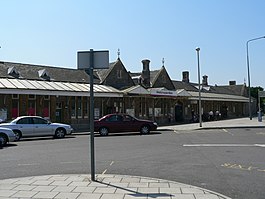Weston-super-Mare railway station
| Weston-super-Mare |
|
|---|---|
 |
|
| Location | |
| Place | Weston-super-Mare |
| Local authority | North Somerset |
| Coordinates | 51°20′41″N 2°58′18″W / 51.3446°N 2.9716°WCoordinates: 51°20′41″N 2°58′18″W / 51.3446°N 2.9716°W |
| Grid reference | ST324610 |
| Operations | |
| Station code | WSM |
| Managed by | Great Western Railway |
| Number of platforms | 2 |
| DfT category | C2 |
| Live arrivals/departures, station information and onward connections from National Rail Enquiries |
|
| Annual rail passenger usage* | |
| 2011/12 |
|
| 2012/13 |
|
| 2013/14 |
|
| 2014/15 |
|
| 2015/16 |
|
| History | |
| Original company | Bristol and Exeter Railway |
| Pre-grouping | Great Western Railway |
| Post-grouping | Great Western Railway |
| 1841 | Terminus opened |
| 1866 | Replaced by second station |
| 1884 | Replaced by present station |
| 1972 | Branch line singled |
| National Rail – UK railway stations | |
| * Annual estimated passenger usage based on sales of tickets in stated financial year(s) which end or originate at Weston-super-Mare from Office of Rail and Road statistics. Methodology may vary year on year. | |
|
|
|
Weston-super-Mare railway station serves the seaside town of Weston-super-Mare in North Somerset, England. It is situated on a loop off the main Bristol to Taunton Line.
The station is operated by Great Western Railway (formerly First Great Western). It consists of two platforms linked by a covered footbridge which is also used as a public footpath between roads on either side of the station. Trains may use either platform in either direction, and many services are booked to pass each other at the station.
The Bristol and Exeter Railway arrived in Weston-super-Mare on 14 June 1841. This was not the route that serves today's station, but rather a single-track branch line from Weston Junction railway station, midway between the present-day Worle and Uphill junctions, which terminated at a small station in Regent Street close to the High Street.
The trains on this first branch line were made up of two or three small carriages which were hauled by a team of three horses. It was reported that, when a strong wind was blowing towards the train, passengers sometimes got out and walked as it could be quicker! By 1850 a limited number of trains were being worked by steam locomotives, but horses continued to be used on certain trains until 31 March 1851.
The station had a train shed that covered two tracks, although only one passenger platform was provided. Between this and the High Street was the Railway Hotel; in the other direction a level crossing was provided to carry the line across Locking Road, the eastwards continuation of Regent Street. A small engine shed was eventually provided here to house the steam locomotive.
After closure, the land was eventually gifted to the town and planted with trees, giving rise to its unofficial name of "The Plantation". A floral clock was built on the site of the station building. Although the mechanism has not worked for many years, the raised flower bed is still planted each year to commemorate a local or national event. Next to this is a scale replica of North Star, the first locomotive to run on the Great Western Railway. It was erected in 2006 to commemorate to 200th anniversary of the birth of Isambard Kingdom Brunel, the engineer who designed this first station. The Railway Hotel is currently known as Tavern Inn the Town.
...
Wikipedia
